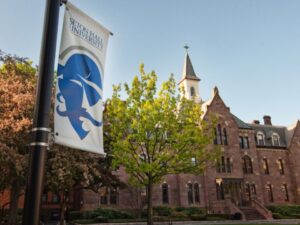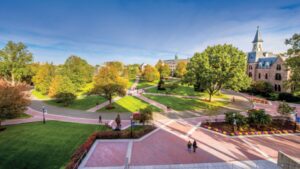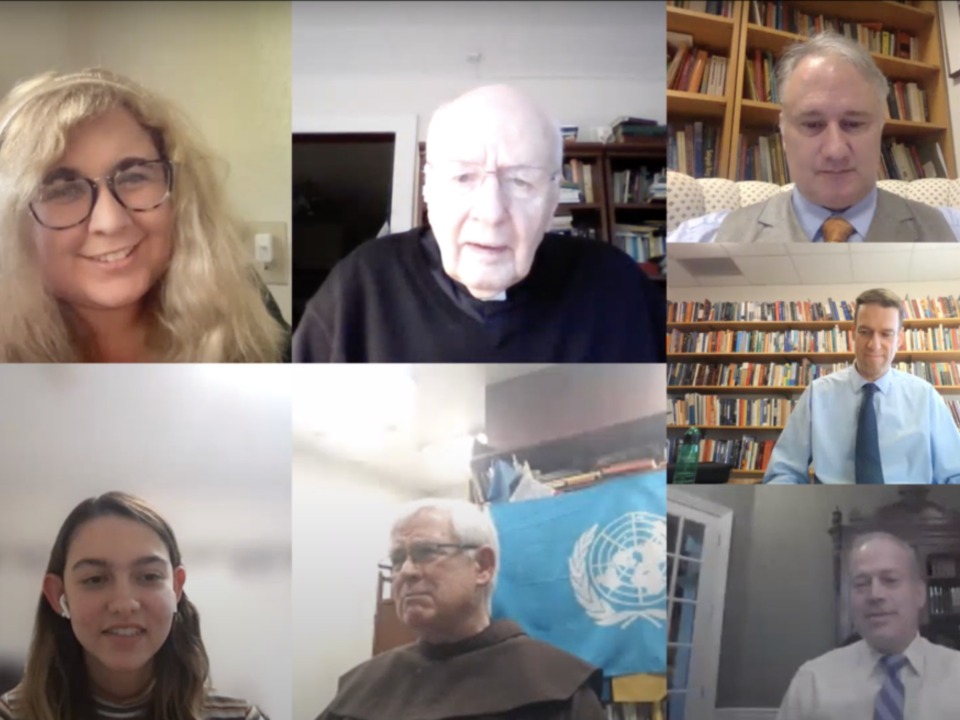Six panelists representing the Catholic Church and The Church of Jesus Christ of Latter-day Saints participated in a first-of-its-kind interfaith dialogue this month at Seton Hall University, a private, Catholic college in South Orange, New Jersey.
The event followed a milestone connection between the two churches in 2019, and participants said it advanced this important new direction in religious communication.
Members of the panel took questions and discussed the relationship between the two churches. They also described past experiences with interfaith dialogue and brainstormed ways to continue in friendship and communication.
Seton Hall University is one of the nation’s leading Catholic universities, established in 1856. The idea for the interfaith panel came from a senior student, Ellen Paul, who is writing a thesis on the relationship between the Catholic Church and The Church of Jesus Christ of Latter-day Saints.

One of the most historic moments in the two churches’ history together came in 2019 in Rome, Italy, when President Russell M. Nelson became the first president of the Church to meet with a Roman Catholic pope. President Nelson and Pope Francis also shared a warm embrace, which Paul called a milestone for interChurch relations.
Paul has a unique outlook on this topic. She was baptized into the Church in March 2020 while attending Seton Hall. She is now a member of the Scotch Plains New Jersey Stake.
Paul worked closely with Associate Professor Jon Radwan, who serves as director of Seton Hall’s Institute for Communication and Religion, which hosted the event. The Institute regularly holds events that contribute to public dialogue and debate on religious issues.
Paul invited three Latter-day Saints and three Catholics to be on the virtual panel, and they participated via videoconference from New Jersey, New York, Massachusetts and Utah on Friday, November 12.
Positive Dialogue
Panelist Hanna Seariac lived first as a Catholic and now lives as a Latter-day Saint; she currently attends Brigham Young University in Provo, Utah. Paul directed the first question to her, asking how both groups can facilitate positive dialogues in their everyday lives.
“I think the most important thing is trying to understand each other and not making caricatures of the various beliefs,” responded Seariac. She said assuming things about the other religion or thinking they don’t have a desire to understand sometimes leads to prejudices against the other group.
“The most important thing when approaching the dialogue is just trying to understand what someone actually believes and not necessarily placing a value judgment on that belief.” —Hanna Seariac, panelist
“The most important thing when approaching the dialogue is just trying to understand what someone actually believes and not necessarily placing a value judgment on that belief,” said Seariac.
Panelist Corey Chivers, from the Scotch Plains New Jersey Stake, agreed.
“Just the ability to relate to each other and … in everyday point-of-view in terms of living your religion and … leaving what you believe and supporting each other, I think there’s great value in that,” said Chivers, who was recently released from the stake presidency and served on the Summit New Jersey Interfaith Council.
Catholic and Latter-day Saint panelists participate in a virtual interfaith dialogue sponsored by Seton Hall University, in Seton Hall University in South Orange, New Jersey, on Nov. 12, 2021. Image is a screenshot from the panel, courtesy of Church News.All rights reserved.
Two of the panelists said their friendship has led to more understanding and dialogue between their different religions. Mauro Properzi and Mathew Schmalz knew each other academically at first, then their relationship grew to talking about their children and families. Properzi grew up as a Latter-day Saint living in Italy and is an associate professor at BYU, while Schmalz is a Catholic scholar at the College of the Holy Cross in Worcester, Massachusetts.
“We know each other as friends, and that creates a level of trust [and] a level of understanding that really opens the doors to all kinds of different and difficult conversations,” said Properzi. “Just build relationships of friendship and brotherhood and sisterhood with your neighbors, and then from there you can move on to so many other different things.”
Panelist Monsignor John Radano from Seton Hall University explained some of the teachings of the Catholic Church. Monsignor Radano participated in the World Conference on Religion and Peace and has long been involved in inter-religious efforts.
“It is through dialogue, the ecumenical dialogues that we have, that we’ve learned how much we have in common,” said Monsignor Radano.
The sixth panelist was the Rev. Dan Dwyer, who participated in a dialogue at Utah Valley University UVU in 2015 with Schmalz and Properzi. Dwyer is an associate professor of history at Siena College in Loudonville, New York, and while he is Catholic, he is also a longtime member of the Mormon History Association. That makes him a kind of inside outsider, he said.
A Commonality
Dwyer said he sees a commonality between members of both churches in an increasingly secular world. People of faith speak a language that can make sense to other people of faith, even when they don’t agree on dogma. It is easier to bridge a gap between religions when you are religious.
“We mean different things by the words,” said Dwyer, referring to baptism, apostasy or the Trinity. “Sometimes the words get in the way, and the reality of human relationships sometimes transcend[s] definition.”
Talking about theology is important, he said, but moving beyond those conversations allows you to see the similarities on a day-to-day level.

“When we start talking and start taking each other seriously as brothers and sisters in Christ, new possibilities will open for all of us,” — Mathew Schmalz, Catholic scholar
A portion of the panel discussion focused on ways the two international churches have partnered together to provide relief or service around the world. Monsignor Radano mentioned people working side-by-side as well as organizations like Catholic Relief Services and Latter-day Saint Charities partnering together.
They also talked about social justice. Schmalz said he found a really powerful example for his fellow Catholics while reading King Benjamin’s sermon in the Book of Mosiah.
“There’s a lot of what the LDS tradition talks about in terms of social justice that moves beyond simple political action that Catholics can benefit greatly from,” said Schmalz.
In return, Seariac said she admired the Catholic social justice tradition.
“I think that’s something that as Latter-day Saints and Catholics, we can link arms in trying to relieve poverty and to carry people[’s] burdens, especially in a … day and age where I think we see them so much … more frequently because we have social media, so we become more attuned to the suffering of the world,” she said.
Strengthening Relationships
A few questions for the panel included how faith can strengthen youth and families. Chivers spoke about high school seminary and the Come, Follow Me curriculum. Seariac highlighted the Young Men and Young Women programs. Dwyer praised the Church for its missionary program.
Properzi, who is also the chair of the BYU Religious Outreach Council, said he admired the Catholic Church for its liturgical calendar, specifically Holy Week and Easter.
Paul wrapped up the panel by asking about the Catholic and Latter-day Saint relationship moving forward.
Seariac and Monsignor Radano spoke again about coming together to help the poor. Seariac said that would build unity, and help “find ways to lead others to Jesus Christ and be ourselves brought to Jesus Christ … not as separate denominations but as a family of God,” she explained.
Seton Hall University is in South Orange, New Jersey. Photo courtesy of Seton Hall University, courtesy of Church News.All rights reserved.
The panelists all agreed they want to have more dialogue in the future. Many said talking about their faith with others helps them understand it more themselves.
“I think one thing about dialogue or one thing that’s necessary about dialogue is an openness to grace or an openness to surprise, and that in some ways, when we start talking and start taking each other seriously as brothers and sisters in Christ, new possibilities will open for all of us,” said Schmalz.
A Stepping-Stone
Paul said the panel went better than she could have imagined. She was pleased with how the panelists interacted and shared personal stories.
“These are six people who care about interfaith dialogue, and they see the others as brothers and sisters in Christ,” she said.
Paul said it was a big step for Seton Hall, which has had interfaith dialogue with other faiths but never Latter-day Saints. The Institute for Communication and Religion had already made history at the university in 2019 when Swami Sarvapriyananda of the Vedanta Society of New York, the oldest Hindu organization in the U.S., became the first Hindu dignitary to deliver a public lecture, which also focused on religious harmony.
“This is a stepping-stone. I hope it will continue for the school, and I hope that somehow I can continue to tie this idea of interfaith and bringing people together in my life,” she said.



